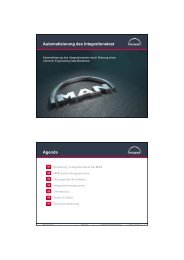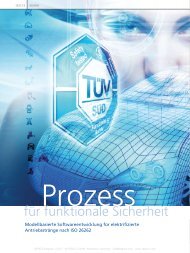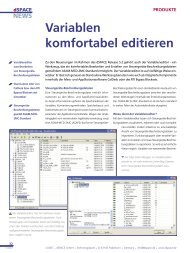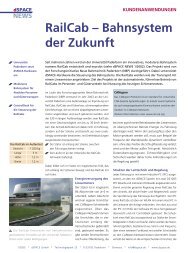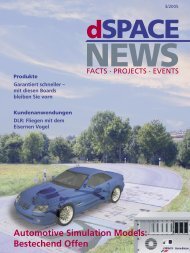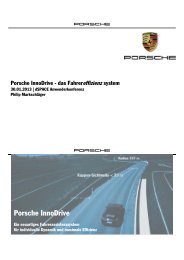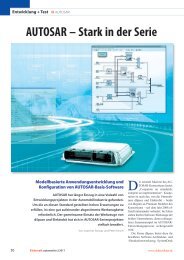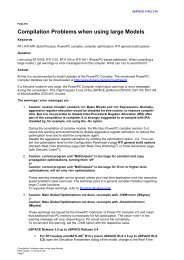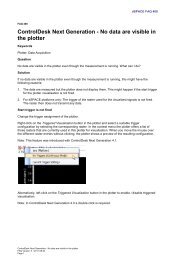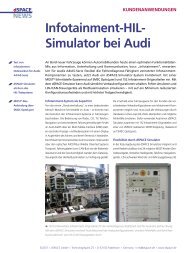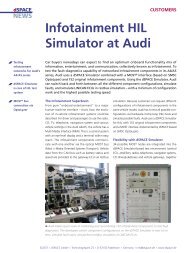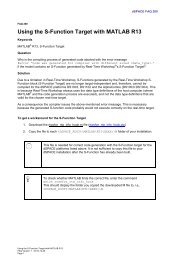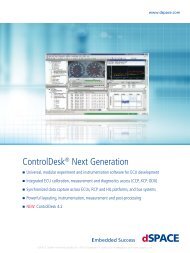magazinE - dSPACE
magazinE - dSPACE
magazinE - dSPACE
You also want an ePaper? Increase the reach of your titles
YUMPU automatically turns print PDFs into web optimized ePapers that Google loves.
Interior<br />
lights<br />
SWC SWC<br />
SWC<br />
Interior<br />
lights<br />
SWC SWC<br />
SWC<br />
SWC SWC<br />
SWC<br />
Fig. 4: In the top-down approach, first the functionality is divided into several SWCs,<br />
and then their interfaces are defined at architecture level.<br />
for new interfaces. The derived<br />
interfaces will not profit from this for<br />
the time being.<br />
To ensure that the SWCs are compatible<br />
with one another, modeling<br />
rules are used to ensure that the<br />
only interfaces used are the ones in<br />
the pool. If necessary, a coordinator<br />
must add further interfaces to the<br />
pool.<br />
Creating new Vehicle Functions<br />
with the Top-Down Strategy<br />
The modeling of new vehicle functions<br />
begins at architecture level,<br />
with the descriptions of the SWC<br />
interfaces in the COP database<br />
described above. This involves creating<br />
ports with types defined by<br />
interfaces. Runnables and their<br />
subsets of the SWC interface are<br />
also defined. RTE events are used to<br />
define the runnables’ cycle times<br />
and, if necessary, event triggers such<br />
as the receipt of a new signal.<br />
Finally, an AUTOSAR SWC description<br />
is generated from this.<br />
Interior Functions<br />
Electrical<br />
system<br />
Electrical<br />
system<br />
Exterior<br />
lights<br />
Exterior<br />
lights<br />
This AUTOSAR description is the<br />
basis for behavior modeling. The<br />
SWC descriptions are imported<br />
into the Data Dictionary and a<br />
modeling frame is generated as<br />
the starting point for modeling a<br />
behavior function. The modeling<br />
frame contains the relevant<br />
AUTOSAR interfaces and runnables,<br />
using the TargetLink AUTOSAR<br />
blocks (fig. 5). The frame is then<br />
filled with standard blocks for modeling<br />
the actual algorithms. Any<br />
changes to the interface are always<br />
performed in the database.<br />
migrating Existing models in the<br />
Bottom-up Strategy<br />
Existing behavior models were migrated,<br />
using the interface definition<br />
for deriving and typing the ports.<br />
We were able to automate virtually<br />
90% of model migration, since we<br />
already had modeling conventions<br />
for using the names of the associated<br />
communication matrix signals<br />
for input and output variables.<br />
Glossary<br />
Composition – In a composition,<br />
several SWCs are grouped and<br />
connected to form one superordinate<br />
component.<br />
DBC file – Database container file.<br />
Communication matrix description<br />
file for CAN.<br />
Communication matrix – Describes<br />
the signals/data exchanged between<br />
individual ECUs.<br />
nVRam – Nonvolatile random access<br />
memory, used for storing diagnostic<br />
information, etc.<br />
Runnable – An executable element<br />
in an AUTOSAR SWC, comparable to<br />
a function.<br />
System architecture tool – Used for<br />
planning and integrating complex<br />
ECU architectures. It can import,<br />
export, and modify AUTOSAR files.<br />
Fig. 5: Frame model created with TargetLink.<br />
pAGe 11



